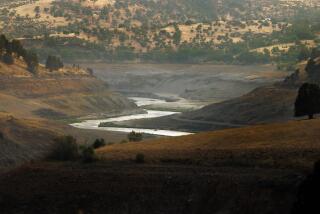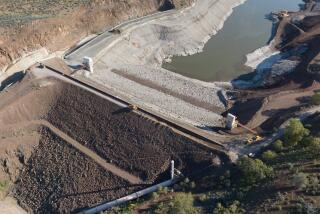Floyd E. Dominy dies at 100; federal water official oversaw major dam projects
Floyd E. Dominy, a federal water official with an outsize personality who shepherded some of the Westâs last big dam projects to completion, has died. He was 100.
Dominy, who served as commissioner of the U.S. Bureau of Reclamation from 1959 to 1969 under four presidents, died April 20 at his farm in Boyce, Va.
Politically connected, smart and determined, Dominy loomed large in Western water circles. He believed that a good river was a dammed river and ran the bureau before landmark environmental laws made it harder to push through projects with little regard for ecological consequences.
âHe relished the power he had and used it to do what he thought was the right thing to do for the country,â said Roger Patterson, a former reclamation official who is now assistant general manager of the Metropolitan Water District of Southern California. âHe was a legend.â
Dominyâs tenure is best known for the opening of Glen Canyon Dam, which plugged the Colorado River and flooded a glorious canyon landscape, creating Lake Powell. Conservationists considered the dam one of the worst environmental sins in the West. Dominy called it his âcrowning jewel.â
âHe was a man who was promoting reclamation at a time of big dam building when people didnât understand the environmental cost of big dams nor the spiritual and societal value of free-flowing rivers,â said Bruce Hamilton, deputy executive director of the Sierra Club.
In a 1971 New Yorker excerpt of his book âEncounters with the Archdruid,â John McPhee recounts a rafting trip down the Colorado River with the cigar-puffing Dominy and David Brower, the late conservationist who never forgave himself for not stopping Glen Canyonâs construction.
âDominy and Brower are drinking beer,â McPhee wrote. âThey have settled into a kind of routine: Once a day they tear each other in half and the rest of the time they are pals.â
At one point, Brower laments that âLake Powell is a drag strip for power boats. ⌠The magic of Glen Canyon is dead. It has been vulgarized.â
Retorts Dominy: âIâm a greater conservationist than you are, by far. I do things. I make things available to man. Unregulated, the Colorado River wouldnât be worth a good God damn to anybody.â
Dominy was born Dec. 24, 1909, on a Nebraska homestead and grew up under the harsh rhythms of subsistence farming, helping his family scratch a living out of 160 acres.
He graduated from the University of Wyoming with a degree in agricultural economics. In 1934, amid drought and the Great Depression, he was appointed agricultural agent in Campbell County, Wyo. It was there that he embarked on his dam-building career, working with local ranchers to erect small dams on ephemeral creeks to catch storm water for their scrawny cattle.
In 1937, on the drive back from a vacation trip to California to see the Rose Parade, he stopped at the Bureau of Reclamationâs new showcase, Hoover Dam. He left thinking it was magnificent. Within a decade he was working for the bureau, rising to the rank of assistant commissioner by 1957. He was appointed commissioner in 1959 and served under Presidents Eisenhower, Kennedy, Johnson and Nixon.
Profane, hard-driving and self-assured, Dominy kept the money flowing for water projects by carefully cultivating members of Congress and doing his homework. âHe was the best person to testify before Congress that Reclamation ever had,â said Brit Storey, the agencyâs senior historian.
In an interview for a public television documentary, Dominy said that early in his career he learned the importance of being well prepared.
âNever go before a committee of Congress unless youâre fully informed as to what it is youâre trying to get,â he said. âAnd treat them with a great deal of respect no matter how stupid the question may be; treat it as if itâs the most adroit question that could have been asked.â
He was not so diplomatic with subordinates. In Marc Reisnerâs book âCadillac Desert,â the late environmental author writes that Dominy could be jovial and amusing, but also had a violent temper and instilled fear in his employees.
âHe was well known to vigorously chastise people,â Storey said. âHe would tear âem up if he thought they had done something wrong.â
Even Reisner, whose 1986 book was a scathing indictment of Western water development and its effect on the environment, was intimidated by Dominy. Patterson said that Reisner called him when he was preparing to interview Dominy for a documentary sequel to his book and was extremely nervous at the thought of a face-to-face encounter.
Dominy retired to a farm in Virginiaâs northern Shenandoah Valley, where he raised Angus cattle. But he remained vocal.
âReclamation was there to create food and fiber. He believed in that to the very end,â Storey said. â He was not going to apologize for a project that accomplished that.â
Dominyâs wife of 53 years, Alice Criswell Dominy, died in 1982. He is survived by his children Janice DeBolt of Grand Junction, Colo., Charles Dominy of Oakton, Va., and Ruth Swart Young of Marshall, Va.; eight grandchildren; 23 great-grandchildren; and a great-great grandchild.
More to Read
Start your day right
Sign up for Essential California for the L.A. Times biggest news, features and recommendations in your inbox six days a week.
You may occasionally receive promotional content from the Los Angeles Times.







